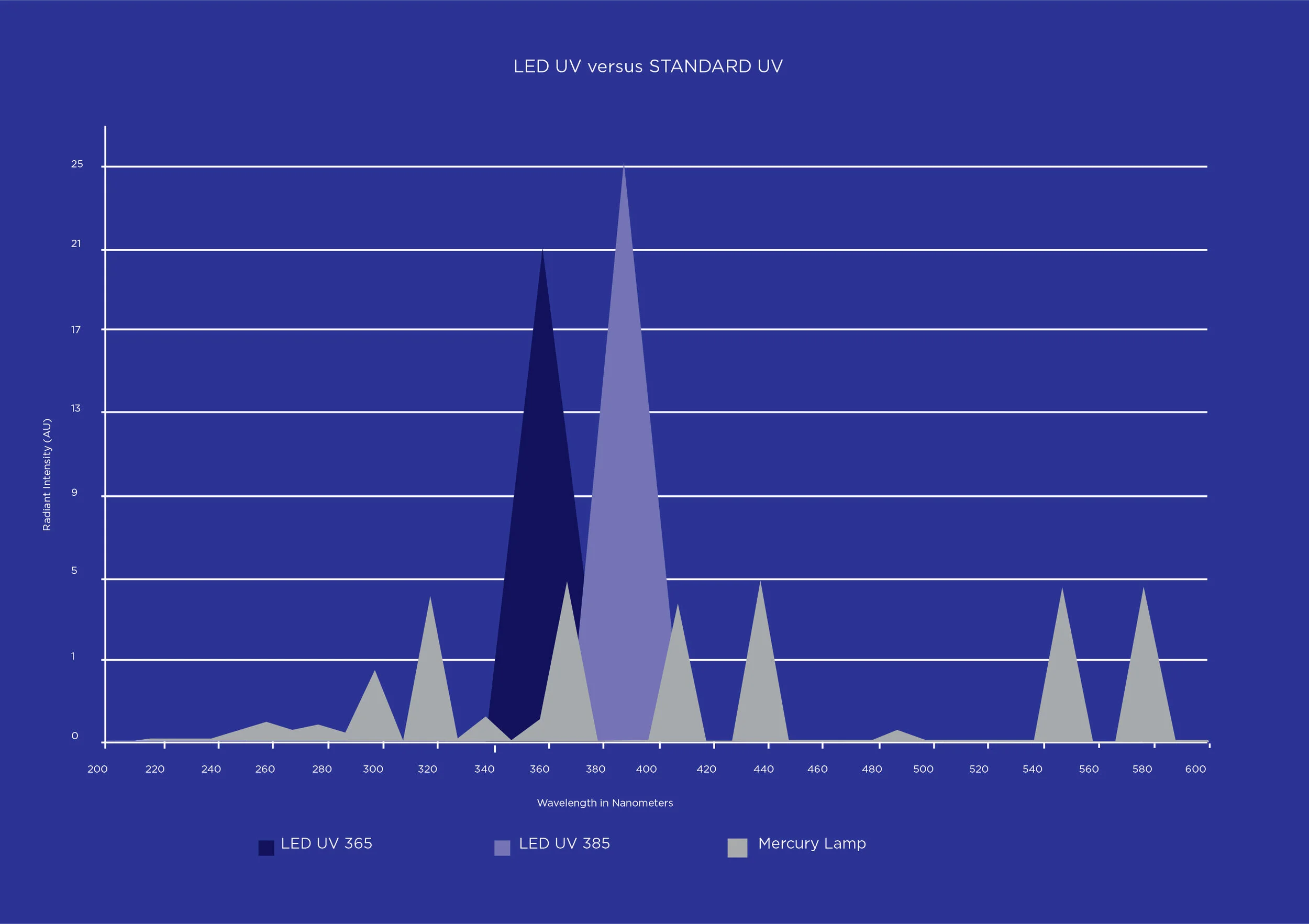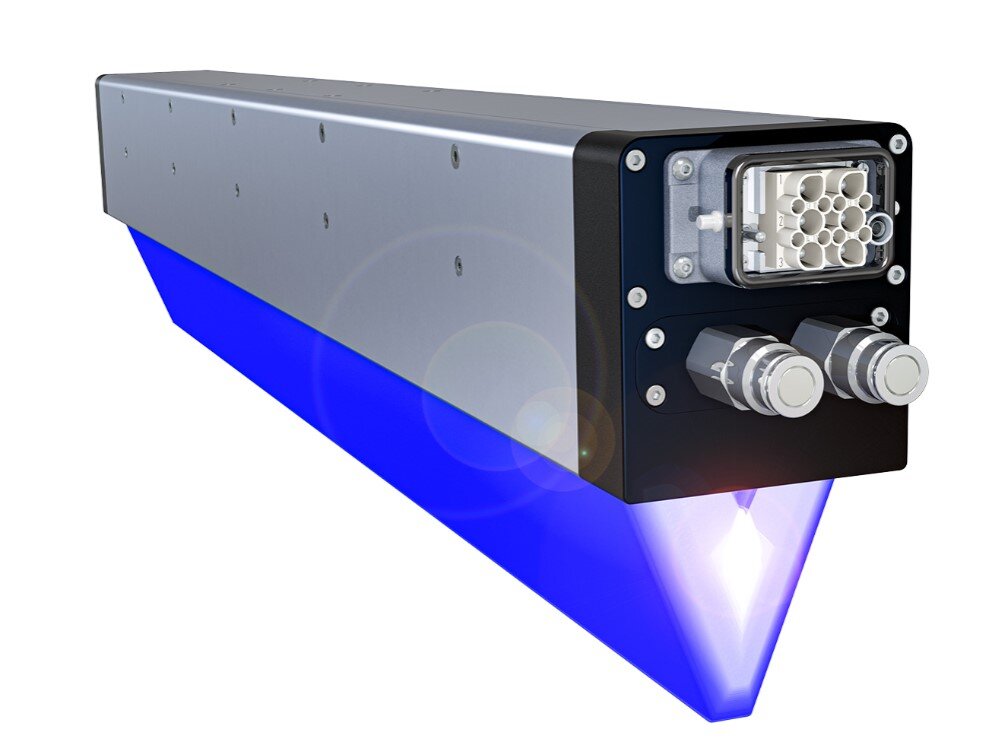LED UV curing uses high-intensity electronic ultraviolet (UV) light to change inks, coatings, adhesives or other photo-reactive substances through polymerization into instantly fixed-in-place solids. “Drying,” by contrast, solidifies chemistry through evaporation or by absorption.
From a cooler, cleaner cure than that achieved with mercury arc bulbs common with conventional processes, to faster and more consistent output, energy savings, and a reduced environmental footprint, its advantages are numerous and measurable to many manufacturing and printing entities.
A LOOK AT LED VERSUS MERCURY ARC LAMP CURING WAVELENGTHS: UV curing systems are widely used by industrial manufacturers in printing, automotive, medical devices, electronics and packaging. They are also used in wood finishing applications including coating and adhesive bonding for assembly, as well as sealing and screen print decorating.
What is UV Curing?
UV curing is a low-temperature, high-speed, solvent-less photochemical process that uses high-intensity electronic ultraviolet (UV) light to change inks, coatings, adhesives or other photo-reactive substances through polymerization into an instantly fixed-in-place solid. “Drying,” by contrast, solidifies chemistry through evaporation or by absorption. Ideally, with UV curing, the cured substances become securely adhered to the substrate onto which they were applied, with adequate depth of cure without being tacky, sticky or flakey.
Types of UV curing include spot curing, flood curing, hand-held curing and conveyor curing. UV curing systems use a variety of lamps as the UV light sources: mercury-based arc lamps which generate broad spectrum UV light; and light emitting diodes (LEDs) that emit only UVA energy. While UVC LEDs are an option, the power output and efficiency is much lower.
Mercury arc (HG type) lamps have long been the predominant standard in UV curing and are widely deployed as solutions for printing and other industrial manufacturing processes. While they work well, they have their downsides. Most significant is that they create substantial heat and consume a large amount of energy. They also produce ozone, which requires exhaust systems to maintain air quality, and mercury-arc bulbs must be disposed of at a cost and under regulatory scrutiny and have a long-term environmental impact.
LED-based UV curing provides all the advantages of traditional UV curing while adding solutions to many of the problems encountered with heat-set drying. They include instantaneous turn-on/turn-off, fast and uniform drying/curing, low heat emission, and low power consumption. Additionally, LED UV’s small-form factor makes it ideal for incorporating into processes or machinery with little available space.
A Cooler, Cleaner Cure
A key advantage of LED UV curing systems is the ability to bypass the heat-related hazards and energy costs of heat-set drying because they do not generate infrared heat and operate at significantly lower temperatures than traditional mercury arc UV curing lamps.
The low amount of heat that is generated with LED UV dissipates from the backside of the module, leaving the substrate side cooler. This allows for printing on a much broader range of heat-sensitive substrates than possible with mercury arc lamps, including films and plastics and other materials that don't absorb inks, without distortion or damage.
The elimination of an intermediary drying step is one of the most significant benefits of UV-curing systems. For offset presses, UV curing eliminates the need for drying powder to prevent sheets from sticking, significantly reducing cleanup and maintenance.
An advantage to all UV-curable inks is that they sit atop the substrate rather than penetrate it the way most other inks do, reducing the amount of ink required to create equivalent image density to conventional inks. This is especially advantageous on non-porous substrates, on which less ink is desirable in order to control the dot size.
With LED UV curing, high-end printing effects, like “drip-off”, also known as "strike through" -- which provides an extreme, visible and tactile contrast between high gloss and matte areas on the sheet -- can be achieved through a “wet-on-wet” process. It also paves the way for further developments in this arena that are broadening creative applications and what is possible with printing.
In addition to the direct advantages of cooler temperatures, faster curing, less material distortion due to heat and no drying step, LED UV reduces job setup and make-ready times, speeding turnaround and opening up capacity.
Environmentally Friendly
LED UV lamps require specially formulated adhesives and inks, which are free of solvents, so LED UV curing eliminates the release of VOCs (volatile organic compounds), minimizing their environmental impact, along with the lower amounts of materials used and waste produced.
Because LED UVs emit UVA energy, the lamps do not generate ozone, which is a byproduct of many print curing processes, including arc UV lamps, that must be exhausted from the work area. LED UV lamps are also free of mercury, a toxic metal that is contained in arc UV lamps, which removes the need to safely handle and dispose of mercury arc bulbs.
The elimination of heat, ozone and mercury from press rooms by using LED-based UV makes them safer. LED UV also eliminates the costs generated by cooling air blowers and ozone extraction systems and the ambient noise and odor associated with other systems, further improving the work environment.
Energy Savings and Faster Production
A rendering of a high-power, twin-beam style LED UV curing module
Another significant advantage of LED-based UV lamps is that they power on only when needed and are immediately ready to cure, versus traditional arc-based lamps which remain on throughout production and require an initial warm-up period that slows production.
In addition to boosting output speed and capacity, the instant on/off process of LED UV substantially lowers the energy usage and stress on lamp bulbs that’s inherent with conventional “always-on” UV mercury lamp curing. LED UV also has no moving parts and eliminates the time spent servicing other parts such as ballasts, shutters, reflectors and fans that are standard in arc-based lamps.
Most LED UV lamps operate an average of 10 times longer -- 10,000 to 20,000 hours of operation -- than arc UV curing lamps, which average a 1,000- to 2,000-hour life, making for more uptime and less maintenance and bulb replacements.
Another benefit of LED UV curing is that it ensures stable output, versus UV arc bulbs that degrade over time. This removes the need for constant monitoring and pre-emptive bulb changing, leading to better process and quality control.
Taking it a step further, operators have the flexibility to program the exact UV energy needed for changing process needs to reduce product waste, expand production capabilities and most efficiently utilize production lines. It is also possible to turn off individual modules in multiple-unit installations to save energy without slowing production speed or compromising quality.
Additionally, lower-heat curing reduces electrical consumption by eliminating need with conventional ink presses for dryers, which in addition to their direct consumption of energy in the printing process, contribute to higher cooling costs in the printing plant.
Gaining Ground in Printing
In printing, LED UV curing is increasingly standard in new digital inkjet, flexographic and offset sheet-fed presses, and there’s a growing movement of printers retrofitting production lines that have existing UV curing systems to LED UV.
The majority of UV-curable inkjet printers on the market use LED-curing as their default curing technology as it has advanced to ensure faster curing and high-quality printing as well as improved production output.
LED UV curing has become predominant in wide-format graphics and label inkjet printing, since the advent of using a small carriage to rapidly move the lightweight lamp across the width of the printer to cure the inks. This could not be achieved with mercury arc lamps due to their heavier weight, large footprint and cooling mechanisms.
For flexographic presses, LED UV’s ability to cure with cooler temperatures is widely adopted as a game changer for printing on thinner films and a wider range of label stocks. Inkjet LED UV-curing leads the market in wide-format graphics primarily because of the ability to print on specialty substrates, and the majority of narrow web presses are sold standard with LED UV curing as well.
While the initial investment of LED systems can be as much as five times the cost of traditional arc UV curing systems, the total lifetime cost of ownership can be lower when calculating the lower operating cost and the longer service life of the LED curing lamps along with process and productivity gains.
LED UV-curing enables printers to produce and finish more documents on a single press, which can allow them to concentrate higher output volumes on fewer devices.
The History of LED UV Curing
Ultraviolet (UV)-enabled curing processes were first used in the 1960s for securing coatings onto furniture. Semiconductor LEDs being used to create UV light is a relatively new process that many printers and converters are still learning about.
Asif Khan can be credited with proving the viability of LEDs for creating ultraviolet light in mid-2001, when his research group at the University of South Carolina created an LED that produced appreciable amounts of UV light at 340nm. The USC group managed to develop LED UV devices that emitted UV-A, UV-B and UV-C light over the course of their research, proving that there was still room for new development in the arena of LED light and its potential uses.
In 2009, Air Motion Systems (now AMS Spectral UV - A Baldwin Technology Company) commercialized a high-intensity, solid-state LED UV curing system designed for the extremely fast curing speeds and high curing intensities/peak irradiance needed for sheet fed offset printing. The development of LED UV provided an alternative to conventional UV systems for solidifying inks, coatings and adhesives as part of the printing process, and revolutionized the options available to commercial printers for drying their inks, along with the long list of productivity, quality, operational and environmental advantages that accompany them.
Outside of printing, the earliest LED UV commercial applications were small-area adhesive and bonding medical device assembly. Today, LED UV’s usage is far beyond what was imagined in the early days, due to its small size, light weight and cool curing capabilities, and as the energy density has increased and costs have decreased. Its use is widespread commercially in graphic arts, wood coatings, electronics, composites, textiles, glass, plastics, household products, pharmaceutical and other markets.
Click here to learn more about LED UV Retrofits
This content was originally published on AMS Spectral UV - A Baldwin Technology Company’s website.



